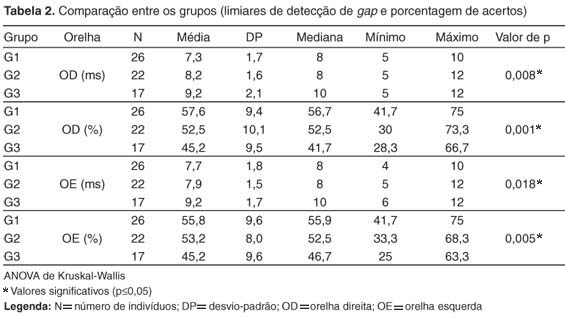PURPOSE: To assess the auditory processing of elderly patients using the temporal resolution Gaps-in-Noise test, and to verify if the presence of hearing loss influences the performance on this test. METHODS: Sixty-five elderly listeners, with ages between 60 and 79 years, were assessed with the Gaps-in-Noise test. To meet the inclusion criteria, the following procedures were carried out: anamnesis, mini-mental state examination, and basic audiological evaluation. The participants were allocated and studied as a group, and then were divided into three groups, according to audiometric results for the frequencies of 500 Hz, 1, 2, 3, 4 and 6 kHz. Thus, subjects in G1 had normal hearing, participants in G2 were classified with mild hearing loss, and those in G3 had moderate hearing loss. RESULTS: In the entire sample, the mean gap detection threshold and the mean percentage of correct responses were, respectively, 8.1 ms and 52.6% for the right ear, and 8.2 ms and 52.2% for the left ear. In G1, these measures were 7.3 ms and 57.6% for the right ear, and 7.7 ms and 55.8% for the left ear. In G2, these measures were 8.2 ms and 52.5% for the right ear, and 7.9 ms and 53.2% for the left ear. In G3, the measures were 9.2 ms and 45.2% for the right and left ears. CONCLUSION: The presence of hearing loss increased the gap detection thresholds and lowered the percentage of correct responses on the Gaps-in-Noise test.
Auditory perception; Aged; Hearing tests; Auditory perceptual disorders; Hearing loss



